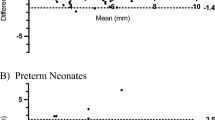Abstract
The aim of this analysis was to study the postnatal short-term outcome of cases with aneurysmal septum primum (ASP) and non-restrictive foramen ovale in otherwise structurally normal hearts. This is a retrospective review of fetuses with ASP referred between 2016 and 2018 to the University Hospital of Cerrahpasa, Department of Fetal Cardiology for cardiac scanning. Prenatal and postnatal clinical features and outcomes for each case were ascertained from the departmental database and from individual clinical hospital records. We presented twenty-four cases which also had postnatal echocardiographic examination in our hospital. At the time of diagnosis of ASP, the mean maternal age was 31.1 ± 5.7 years, the mean gestational age was 28.9 ± 5.9 weeks, the mean birth week was 37.4 ± 3.1 weeks, and the mean birth weight was 2940.8 ± 736.6 g. The postnatal first 3 months prevalences of atrial septal aneurysm, patent foramen ovale and, secundum atrial septal defect (ASD) were 12.5%, 12.5%, 20.8% among fetuses with ASP, respectively. ASP may persist after birth and may increase the frequency of secundum ASD. These data suggest that fetuses with ASP should be followed by a pediatric cardiologist in postnatal life.


Similar content being viewed by others
References
Kiserud T, Rasmussen S. Ultrasound assesment of fetal foramen ovale. Ultrasound Obstet Gynecol. 2001;17:119–24.
Hara H, Virmani R, Ladich E, et al. Patent foramen ovale: current pathology, pathophysiology, and clinical status. J Am Coll Cardiol. 2005;46:1768–76.
Mügge A, Daniel WG, Angermann C, et al. Atrial septal aneurysm in adult patients: a multicenter study using transthoracic and transesophageal echocardiography. Circulation. 1995;91:2785–92.
Marazanof M, Roudaut R, Cohen A, et al. Atrial septal aneurysm. Morphological characteristics in a large population: pathological associations. A French multicenter study on 259 patients investigated by transoesophageal echocardiography. Int J Cardiol. 1995;52:59–65.
Guntheroth WG, Schwaegler R, Trent E. Comparative roles of the atrial septal aneurysm versus patent foramen ovale in systemic embolization with inferences from neonatal studies. Am J Cardiol. 2004;94:1341–3.
Miranda B, Fonseca AC, Ferro JM. Patent foramen ovale and stroke. J Neurol. 2018;265:1943–9.
Kutty S, Sengupta PP, Khandheria BK. Patent foramen ovale: the known and the to be known. J Am Coll Cardiol. 2012;59:1665–71.
Mas JL, Arquizan C, Lamy C, et al. Recurrent cerebrovascular events associated with patent foramen ovale, atrial septal aneurysm, or both. New Engl J Med. 2001;345:1740–6.
Overell JR, Bone I, Lees KR. Interatrial septal abnormalities and stroke: a meta-analysis of case-control studies. Neurology. 2000;55:1172–9.
Channig A, Szwast A, Natarajan S, et al. Maternal hyperoxygenation improves left heart filling in fetuses with atrial septal aneurysm causing impediment to left ventricular inflow. Ultrasound Obstet Gynecol. 2015;45:664–9.
Firpo C, Zielinsky P. Mobility of the flap valve of the primary atrial septum in the develo** human fetus. Cardiol Young. 1998;8:67–70.
Scheuerle A. Clinical differentiation of patent foramen ovale and secundum atrial septal defect: a survey of pediatric cardiologists in Dallas, Texas, USA. J Registry Manag. 2011;38(1):4–8.
Hung JH, Lu JH, Hung CY. Prenatal diagnosis of atrial septal aneurysm. J Clin Ultrasound. 2008;36:51–2.
Pinette MG, Pan Y, Pinette SG, et al. Fetal atrial septal aneurysm. Prenatal diagnosis by ultrasonography. J Reprod Med. 1997;42:459.
Tague L, Donofrio MT, Fulgium A, et al. Common findings in late-gestation fetal echocardiography. J Ultrasound Med. 2017;36:2431–7.
Ozcelik N, Atalay S, Tutar E, et al. Prevalence of interatrial septal aneurysm in newborns and their natural course. Pediatr Cardiol. 2006;27:343–6.
Bassareo PP, Fanos V, Puddu M, et al. High prevalence of interatrial septal aneurysm in young adults who were born preterm. J Matern Fetal Neonatal Med. 2014;27:1123–8.
Van der Linde D, Konings EE, Slager MA, et al. Birth prevalence of congenital heart disease worldwide. A systematic review and meta-analysis. J Am Coll Cardiol. 2011;58:2241–7.
Ostermayer SH, Srivastava S, Doucette JT, et al. Malattached septum primum and deficient septal rim predict unsuccessful transcatheter closure of atrial communications. Catheter Cardiovasc Interv. 2015;86:1195–203.
Carerj S, Narbone MC, Zito C, et al. Prevalence of atrial septal aneurysm in patients with migraine: an echocardiographic study. Headache. 2003;43:725–8.
Uzun O, Babaoglu K, Ayhan YI, Moselhi M, Rushworth F, Morris S, Beattie B, Wiener J, Lewis MJ. Diagnostic ultrasound features and outcome of restrictive foramen ovale in fetuses with structurally normal hearts. Pediatr Cardiol. 2014;35:943–52.
Di Tullio MR, Sacco RL, Sciacca RR, et al. Patent foramen ovale and the risk of ischemic stroke in a multiethnic population. J Am Coll Cardiol. 2007;49:797–802.
Funding
This paper received no specific grant from any funding agency, commercial, or not-for-profit sectors.
Author information
Authors and Affiliations
Contributions
All authors contributed to the study conception and design. Conceptualization: AO and FO methodology; AO, FO, and RM material preparation, data collection and analysis; AO, RD, EAD, RM, and FO the first draft of the manuscript was written by AO and all authors commented on previous versions of the manuscript. All authors read and approved the final manuscript.
Corresponding author
Ethics declarations
Conflict of interest
The authors declare that they have no conflict of interest.
Ethical Approval
This retrospective study is in accordance with the ethical standards of the institution and with the 1964 Helsinki declaration and its later amendments or comparable ethical standards.
Research Involving with Humans and Animals Rights
This article does not contain any studies with human participants or animals performed by any of the authors.
Informed Consent
The need for informed consent was waived by the IRB.
Additional information
Publisher's Note
Springer Nature remains neutral with regard to jurisdictional claims in published maps and institutional affiliations.
Rights and permissions
About this article
Cite this article
Ozel, A., Dedeoglu, R., Davutoglu, E.A. et al. Outcome of Aneurysmal Septum Primum with Non-restrictive Foramen Ovale in Fetuses with Structurally Normal Hearts: A Tertiary Center Experience. J. Fetal Med. 7, 155–159 (2020). https://doi.org/10.1007/s40556-020-00248-5
Received:
Accepted:
Published:
Issue Date:
DOI: https://doi.org/10.1007/s40556-020-00248-5




